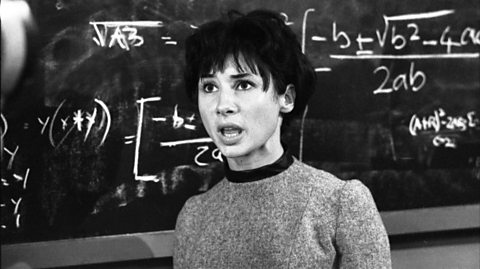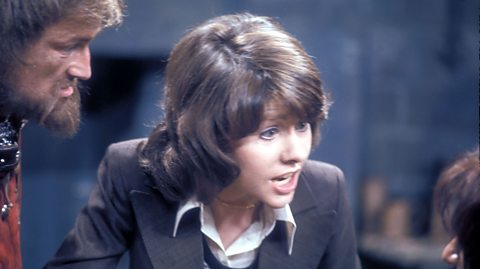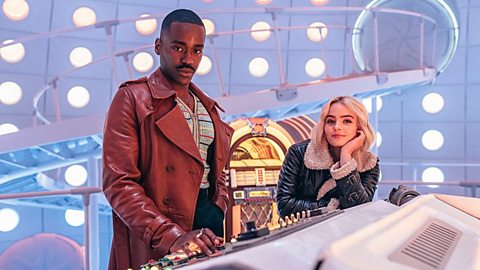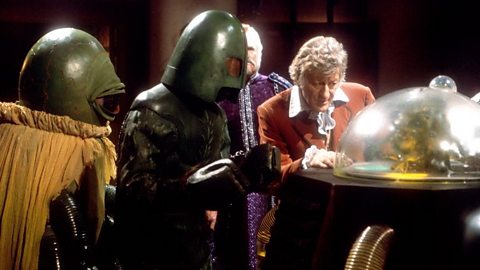When Doctor Who returns to our screens for Ncuti Gatwa’s second season as the time travelling hero, there will be a new passenger aboard the TARDIS.
Varada Sethu is joining the BBC sci-fi series as Belinda Chandra, a nurse who becomes caught up in the Doctor’s adventures and is desperate to get back home to Earth.
Ever since the series began in 1963, the Doctor has shared their travels with fellow passengers from different times and places. Over those six decades, the representation of female companions has changed a lot, with episodes often reflecting the views prevalent in society at the time they were first broadcast. Bitesize took a look at three characters from Doctor Who history to see the extent of these changes with the help of Professor Amy Holdsworth, an expert in film, television and cultural studies at the University of Glasgow.
Susan Foreman: The Doctor’s granddaughter
In a 2023 interview with Radio Times, Carole Ann Ford, the actor who played The Doctor’s mysterious granddaughter Susan Foreman in the first 13 months of the show, spoke of her fondness for - and frustrations with - the role. She said: “I was a trained dancer, acrobat, swimmer, horse-rider, so just think of what they could have flung at me - which they didn’t… if only they had allowed me to do some more courageous things.”

Instead of becoming an action-based heroine, similar to Cathy Gale (Honor Blackman) who was already on UK screens in the ITV series The Avengers, Susan became a relatively passive character alongside William Hartnell’s Doctor. Professor Holdsworth argues this was a reflection of the series needing to establish the main character early on: “You always have to think about the companion’s function in the series and they're always in relation to the Doctor. So, you've got the Doctor's granddaughter in that relationship. Besides the patrician qualities of that early Doctor - as well, the companions are there to support the role, and our understanding of [the character].
“They're there to be a kind of stand-in for an audience, to react to alien worlds or the Doctor's genius.”
In Ncuti Gatwa’s first full season as the Doctor in 2024, numerous references were made to Susan - which made some viewers believe she was coming back. Prof Holdsworth said this possibility could mark an intriguing character development: “What's perhaps more interesting to people about Susan are the unanswered questions. Who is she? Where does she come from? Particularly in that we've had this figure of the Doctor as this lonely, solitary character for so many years that there are still these question marks about Susan.
“Perhaps, in a way, it's the the fact that she was looked at by some as a two-dimensional character that some of those questions remain tantalising to Doctor Who fans - and perhaps an opportunity to go back and revisit the character.”
Sarah Jane Smith: Independent journalist
The UK’s first conference on the Women’s Liberation Movement took place in Oxford in 1970. In mid-December 1973, the strong-minded journalist Sarah Jane Smith (Elisabeth Sladen) made her debut alongside Jon Pertwee’s Doctor in the story The Time Warrior. Sarah Jane retained a long association with the Time Lord, even after they stopped travelling together, sharing adventures with David Tennant’s 10th Doctor and also Matt Smith’s incarnation in her CBBC spin-off series The Sarah Jane Adventures.

Prof Holdsworth recognised the move to create a stronger female companion, but is unsure it completely worked: “You have this moment in the mid ‘70s of secondary feminism and we have a production team realising that they need to reflect the kind of changes that, in terms of relation to society at large, introduce a character that is meant to be independent and self-sufficient.”
Sarah Jane’s investigative career perhaps marked her biggest development. Prof Holdsworth explained: “[Sarah] wants to go out and solve the mysteries rather than just reacting to the environment. But her character also has got that professional identity she inhabits, a job that is perhaps more associated with a male profession. It’s about creating a more three-dimensional character. She has an identity outside of the Doctor and that also shapes the way she responds to the kind of adventures and scrapes she gets involved in as well.”
Yasmin Khan: Police officer
The TARDIS leaps forward more than four decades now. The original Doctor Who series ended in 1989. Following a one-off TV movie in 1996, the revived series began in 2005 with a succession of female companions who seemed very different from those who had come before. They had home lives, we met their families, had glimpses of them at work and occasionally saw them develop romantic feelings for the Doctor.

In 2018, viewers met Yasmin (or Yaz) Khan, a police officer from Sheffield, who first encounters the Doctor shortly after their regeneration. Jodie Whittaker was the first woman in the lead role and Yaz, played by Mandip Gill, was there for every episode of her run. As well as being a positive representation of a young Asian woman having a challenging career, with skills that transfer into her adventures, Yaz also developed a deep, romantic admiration for the Doctor.
Professor Holdsworth said: “The interesting things about the relationship between the Doctor and the companions [in the revived series] is that the Doctor is a lonely figure but the companions are defined by their relationships with extended families, or workplaces or jobs. This becomes a playoff between the Doctor’s loneliness and the companion’s embeddedness with their family and we have the drama and emotional themes that come through those tensions. Part of that is the emphasis on unfulfilled romance between the Doctor and the companions.”
She also elaborated on the show’s aim of inclusivity, represented here by Yaz’s feelings for the Doctor reflecting LGBTQ+ romance, adding: “I think it's also part of that longer history in Doctor Who about empathy and the whole thing about sci-fi. It's about exploring new and different and wonderful worlds and they could be scary. But they can also expand your horizons and you can imagine new possibilities and new ways of being.”
In a concluding note, Prof Holdsworth observed the opportunities analysing a series that has been part of UK culture for more than six decades brings.
She said: “It can function as a barometer. It’s changing attitudes towards gender, but I think you don’t lose sight of the way Doctor Who has reflected changes in television, the way that stories get told and the ways in which genres develop. I think a lot of the changes we see in the companion are obviously reflecting the different place of women in society, but also the different kinds of storytelling and character.”
Doctor Who adventures from the 1960s right through to the 2020s are available to watch on BBC iPlayer.
The new series of Doctor Who can be watched on BBC One and iPlayer from Saturday 12 April.
This article was published in April 2025
Quiz: Did it really happen, or is it Doctor Who?
Some of these are bizarre historical events, some are Doctor Who stories - but which?

The Doctor Who guide to Earth history
Just don't mention the Time Lord's involvement in your homework.

The curious parallels between Doctor Who and the headlines
How the Tardis took the Time Lord to miners' strikes, pollution and a world ruled by taxes
